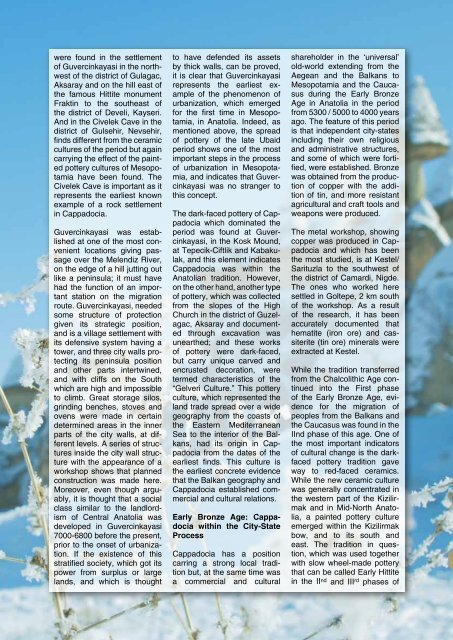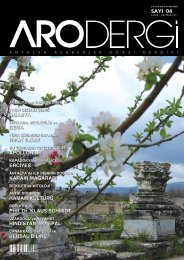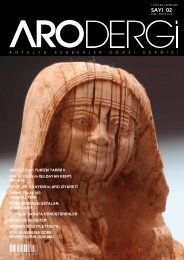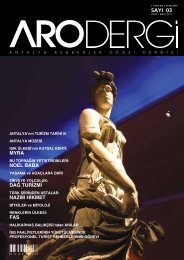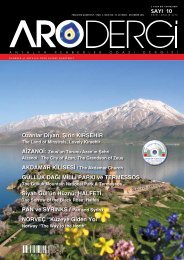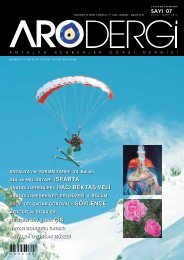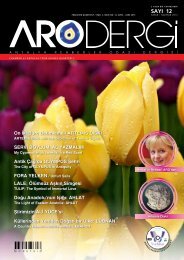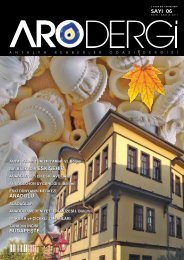Sayı 11- Ocak/Mart 2013 - Antalya Rehberler Odası
Sayı 11- Ocak/Mart 2013 - Antalya Rehberler Odası
Sayı 11- Ocak/Mart 2013 - Antalya Rehberler Odası
- No tags were found...
You also want an ePaper? Increase the reach of your titles
YUMPU automatically turns print PDFs into web optimized ePapers that Google loves.
were found in the settlementof Guvercinkayasi in the northwestof the district of Gulagac,Aksaray and on the hill east ofthe famous Hittite monumentFraktin to the southeast ofthe district of Develi, Kayseri.And in the Civelek Cave in thedistrict of Gulsehir, Nevsehir,finds different from the ceramiccultures of the period but againcarrying the effect of the paintedpottery cultures of Mesopotamiahave been found. TheCivelek Cave is important as itrepresents the earliest knownexample of a rock settlementin Cappadocia.Guvercinkayasi was establishedat one of the most convenientlocations giving passageover the Melendiz River,on the edge of a hill jutting outlike a peninsula; it must havehad the function of an importantstation on the migrationroute. Guvercinkayasi, neededsome structure of protectiongiven its strategic position,and is a village settlement withits defensive system having atower, and three city walls protectingits peninsula positionand other parts intertwined,and with cliffs on the Southwhich are high and impossibleto climb. Great storage silos,grinding benches, stoves andovens were made in certaindetermined areas in the innerparts of the city walls, at differentlevels. A series of structuresinside the city wall structurewith the appearance of aworkshop shows that plannedconstruction was made here.Moreover, even though arguably,it is thought that a socialclass similar to the landlordismof Central Anatolia wasdeveloped in Guvercinkayasi7000-6800 before the present,prior to the onset of urbanization.If the existence of thisstratified society, which got itspower from surplus or largelands, and which is thoughtto have defended its assetsby thick walls, can be proved,it is clear that Guvercinkayasirepresents the earliest exampleof the phenomenon ofurbanization, which emergedfor the first time in Mesopotamia,in Anatolia. Indeed, asmentioned above, the spreadof pottery of the late Ubaidperiod shows one of the mostimportant steps in the processof urbanization in Mesopotamia,and indicates that Guvercinkayasiwas no stranger tothis concept.The dark-faced pottery of Cappadociawhich dominated theperiod was found at Guvercinkayasi,in the Kosk Mound,at Tepecik-Ciftlik and Kabakulak,and this element indicatesCappadocia was within theAnatolian tradition. However,on the other hand, another typeof pottery, which was collectedfrom the slopes of the HighChurch in the district of Guzelagac,Aksaray and documentedthrough excavation wasunearthed; and these worksof pottery were dark-faced,but carry unique carved andencrusted decoration, weretermed characteristics of the“Gelveri Culture.” This potteryculture, which represented theland trade spread over a widegeography from the coasts ofthe Eastern MediterraneanSea to the interior of the Balkans,had its origin in Cappadociafrom the dates of theearliest finds. This culture isthe earliest concrete evidencethat the Balkan geography andCappadocia established commercialand cultural relations.Early Bronze Age: Cappadociawithin the City-StateProcessCappadocia has a positioncarring a strong local traditionbut, at the same time wasa commercial and culturalshareholder in the ‘universal’old-world extending from theAegean and the Balkans toMesopotamia and the Caucasusduring the Early BronzeAge in Anatolia in the periodfrom 5300 / 5000 to 4000 yearsago. The feature of this periodis that independent city-statesincluding their own religiousand administrative structures,and some of which were fortified,were established. Bronzewas obtained from the productionof copper with the additionof tin, and more resistantagricultural and craft tools andweapons were produced.The metal workshop, showingcopper was produced in Cappadociaand which has beenthe most studied, is at Kestel/Sarituzla to the southwest ofthe district of Camardi, Nigde.The ones who worked heresettled in Goltepe, 2 km southof the workshop. As a resultof the research, it has beenaccurately documented thathematite (iron ore) and cassiterite(tin ore) minerals wereextracted at Kestel.While the tradition transferredfrom the Chalcolithic Age continuedinto the First phaseof the Early Bronze Age, evidencefor the migration ofpeoples from the Balkans andthe Caucasus was found in theIInd phase of this age. One ofthe most important indicatorsof cultural change is the darkfacedpottery tradition gaveway to red-faced ceramics.While the new ceramic culturewas generally concentrated inthe western part of the Kizilirmakand in Mid-North Anatolia,a painted pottery cultureemerged within the Kizilirmakbow, and to its south andeast. The tradition in question,which was used togetherwith slow wheel-made potterythat can be called Early Hittitein the II nd and III rd phases of


